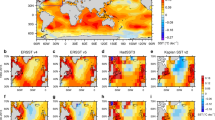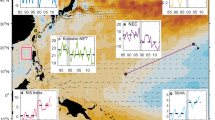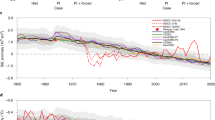Abstract
Evidence for a cooling event synchronous with the Younger Dryas (12,000 calendar years before present) has been found in the North Pacific Ocean north of 30° N in records of surface1–5 and subsurface water properties6,7. These changes may be related to a temporary shut-down of North Atlantic Deep Water formation and associated surface cooling over the North Atlantic. It has remained unclear, however, whether this North Atlantic cooling was communicated to the North Pacific Ocean through the atmosphere or the ocean. Here we report results of a sensitivity experiment with a coupled ocean–atmosphere general circulation model that support a primarily atmospheric forcing of North Pacific climate variations. Changes in wind strongly affect coastal upwelling at the North American west coast, and surface cooling by the atmosphere causes better ventilation of the thermocline waters of the northeast Pacific. This effect is amplified by oceanic progagation to the Pacific of the signal arising from collapse of North Atlantic Deep Water formation. These teleconnections may also explain earlier North Pacific and western North American millenial-scale cooling events of a similar nature8–12.
This is a preview of subscription content, access via your institution
Access options
Subscribe to this journal
Receive 51 print issues and online access
$199.00 per year
only $3.90 per issue
Buy this article
- Purchase on Springer Link
- Instant access to full article PDF
Prices may be subject to local taxes which are calculated during checkout
Similar content being viewed by others
References
Heusser, C. J. Late Pleistocene Environments of North Pacific and North America (Spec. Publ. 35, Geogr. Soc., New York, 1960).
Peteet, D. M. & Mann, D. H. Late-glacial vegetation, tephra, and climatic history of southwestern Kodiak Island, Alaska. Ecoscience 1, 255–267 (1994).
Peteet, D. M. Global Younger Dryas? Quat. Int. 38, 93–104 (1995).
Kallel, N. et al. Evidence of cooling during the Younger Dryas in the western North Pacific. Oceanol. Actal 11, 369–375 (1988).
Keigwin, L. D. & Jones, G. A. Deglacial climatic oscillations in the Gulf of California. Paleoceanography 5, 1009–1023 (1990).
Kennett, J. P. & Ingram, B. L. A 20,000-year record of ocean circulation and climate change from the Santa Barbara Basin. Nature 377, 510–514 (1995).
van Geen, A. et al. Ventilation changes in the northeast Pacific during the last deglaciation. Paleoceanography 11, 519–528 (1996).
Thunell, R. C. & Mortyn, P. G. Glacial climate instability in the Northeast Pacific Ocean. Nature 376, 504–506 (1995).
Behl, R. J. & Kennett, J. P. Brief interstadial events in the Santa Barbara Basin, NE Pacific, during the past 60kyr. Nature 379, 243–246 (1996).
Kotilainen, A. T. & Shackleton, N. J. Rapid climate variability in the North Pacific during the past 95,000 years. Nature 377, 323–326 (1995).
Benson, L. V. et al. Climatic and hydrologic oscillations in the Owens Lake Basin and adjacent Sierra Nevada, California. Science 274, 746–749 (1996).
Philips, F. M. et al. Chronology for fluctuations in Late Pleistocene Sierra Nevada glaciers and lakes. Science 274, 749–751 (1996).
Rooth, C. Hydrology and ocean circulation. Prog. Oceanogr. 11, 131–149 (1982).
Maier-Reimer, E. & Mikolajewicz, U. in Oceanography 1988 (eds Ayala-Castañares, A., Wooster, W. & Yáñez-Arancibia, A.) 87–100 (UNAM, Mexico, 1989).
Rahmstorf, S. Bifurcations of the Atlantic thermohaline circulation in response to changes in the hydrological cycle. Nature 378, 145–149 (1995).
Mikolajewicz, U. & Maier-Reimer, E. Mixed boundary conditions in ocean general circulation models and their influence on the stability of the model's conveyor-belt. J. Geophys. Res. 99, 22633–22644 (1994).
Manabe, S. & Stouffer, R. J. Simulation of abrupt climate change induced by freshwater input to the North Atlantic Ocean. Nature 378, 165–167 (1995).
Schiller, A., Mikolajewicz, U. & Voss, R. The stability of the North Atlantic thermohaline circulation in a coupled ocean-atmosphere general circulation model. Clim. Dyn. (in the press).
Manabe, S. & Stouffer, R. J. Two stable equilibria of a coupled ocean-atmosphere model. J. Clim. 1, 941–866 (1988).
Wright, D. G. & Stocker, T. F. Ice in the Climate System (ed. Peltier, W. R.) 395–416 (Springer, Berlin, 1993).
Stocker, T. F. & Wright, D. G. Rapid changes in ocean circulation and atmospheric radiocarbon. Paleoceanography 11, 773–795 (1996).
Roeckner, E. et al. Simulation of the present-day climate with the ECHAM model: impact of model physics and resolution. (Tech. Rep. No 93, Max-Planck-Inst. für Meteorologie, Hamburg, 1992).
Maier-Reimer, E., Mikolajewicz, U. & Hasselmann, K. Mean circulation of the LSG OGCM and its sensitivity to the thermohaline surface forcing. J. Phys. Oceanogr. 23, 731–757 (1993).
Voss, R. & Sausen, R. Techniques for asynchronous and periodically synchronous coupling of atmosphere and ocean models. Part II: impact of variability. Clim. Dyn. 12, 605–614 (1996).
Voss, R., Sausen, R. & Cubasch, U. Periodically synchronously coupled integrations with the atmosphere-ocean general circulation model ECHAM3/LSG. Clim. Dyn. (submitted).
Fairbanks, R. G. A 17,000-year glacio-eustatic sea level record: influence of glacial melting rates on the Younger Dryas event and deep-ocean circulation. Nature 342, 637–642 (1989).
Goslar, T. et al. High concentration of atmospheric 14C during the Younger Dryas cold episode. Nature 377, 414–417 (1995).
Mikolajewicz, U. A meltwater induced collapse of the ‘conveyor belt’ thermohaline circulation and its influence on the distribution of Δ14C and δ18O in the oceans. (Tech. Rep. 189, Max-Planck-Inst. für Meteorologie, Hamburg, 1996).
Herbert, T. D., Yasuda, M. & Burnett, C. Glacial-interglacial sea-surface temperature record inferred from alkenone unsaturation indices, site 893, Santa Barbara Basin. Proc. ODP 146 (pt 2), 257–264 (1995).
Sautter, L. R. & Thunell, R. C. Seasonal variability in the δ18O and δ13C of planktonic foraminifera from an upwelling environment: Sediment trap results from the San Pedro Basin, Southern California Bight. Paleoceanography 6, 307–334 (1991).
Author information
Authors and Affiliations
Rights and permissions
About this article
Cite this article
Mikolajewicz, U., Crowley, T., Schiller, A. et al. Modelling teleconnections between the North Atlantic and North Pacific during the Younger Dryas. Nature 387, 384–387 (1997). https://doi.org/10.1038/387384a0
Received:
Accepted:
Issue Date:
DOI: https://doi.org/10.1038/387384a0
This article is cited by
-
Hydroclimate response of spring ecosystems to a two-stage Younger Dryas event in western North America
Scientific Reports (2022)
-
Slow and soft passage through tipping point of the Atlantic Meridional Overturning Circulation in a changing climate
npj Climate and Atmospheric Science (2022)
-
Century-scale climatic oscillations during the Last Glacial Maximum revealed by stalagmite isotopic records from Longfugong Cave, China
Environmental Earth Sciences (2020)
-
Enhanced North Pacific deep-ocean stratification by stronger intermediate water formation during Heinrich Stadial 1
Nature Communications (2019)
-
A Great Basin lake-level response to 38–34 ka Dansgaard–Oeschger oscillations
Journal of Paleolimnology (2019)
Comments
By submitting a comment you agree to abide by our Terms and Community Guidelines. If you find something abusive or that does not comply with our terms or guidelines please flag it as inappropriate.



